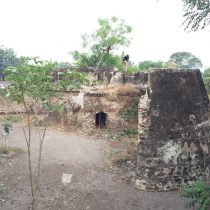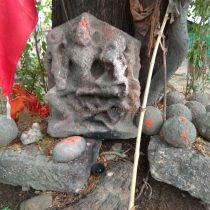NASTANPUR
TYPE : GADHI
DISTRICT : NASHIK
GRADE : EASY
On the way from Nasik to Chalisgaon via Manmad, after crossing Nandgaon, there is a small village called Nastanpur next to the highway. This village is famous in this area because of the Shani Dev temple located here but no one knows about Nastanpur ground fort which is right next to the road in this village. Local people know this fort as “Khoja Raja's” fort. There is no information or record of this fort in history or elsewhere. When locals are asked about this fort, many legends are told but as they are less legends and more myths, it is better to not mention them here. The distance between Nasik-Nastanpur is 128 km and the 30-35 feet high bastions of the fort can be seen as soon as you enter the village from the highway, but the ramparts are not visible to that extent. As soon as you enter the village, you can see some cannonballs and an ancient idol of Shankar Parvati under a tree outside the fort bastion.
...
In this idol, Shankar Parvati is seated on Kailas and Ravan is shown moving the Kailas Mountain. When you come next to this bastion, instead of a ramparts, there is a small wall of five-six feet and you can enter the fort from there. We have to walk in the fort with a handkerchief over our noses as the village has rejected the Swatch Bharat Abhiyan and turned this place into toilet. After reaching the highest bastion of the fort through this path, one can see the entire structure of the fort and the inner ruins from here. This fort is roughly triangular in shape and is spread over an area of 9 acres in the north-south direction and there are a total of eleven bastions in the ramparts of the fort. Although the bastions of the fort and the construction on it are dilapidated, it appears that the construction of the fort was stopped before the construction of the ramparts. Therefore, the crumbling stones of the ramparts are not seen anywhere. The north-facing entrance of the fort is built between two bastions and has a beautiful brick arch above the bastion and the gate. One of these bastions is somewhat dilapidated and cannot be easily accessed. Cannon emplacements are seen here. For the protection of the fort, a trench has been dug in the southern part and the approach to the main gate is through the fort ramparts through the trench. Three bastions are built on this road towards the trench and there are storehouses in these bastions and there is a Ganapati temple outside one of the bastions. There are three big wells in the fort and the water from the biggest well under the bastion is used throughout the fort. There are stairs to go down into this well and the structure near the upper side of the well and at the bottom of the bastion must have been used as a havamahal. There is a mosque in the western corner of the fort and there is a square well in front of this mosque. In the center of the fort is a Bathroom of earlier times, built of carved stone but currently partially collapsed. There is a square well at the back of this toilet and 21 arches are seen in a row on one side, two of which are collapsed. It is said to be a horse stable. Apart from this, three circular water tanks are seen built like wells to store water in the fort and some other buildings are seen in a dilapidated condition. Looking at the construction of the fort, it seems that the fort was built in the beginning of the 18th century and during this period, the British power came to the force and the work was stopped as they forbade further construction. As the fort was partially destroyed, a simple wall six feet high was built around it. Due to the neglect of this fort, it is on the verge of collapse. Local people say that a Bhil king named Khoja Naik became a king at this place and that king built this fort.
© Suresh Nimbalkar





















